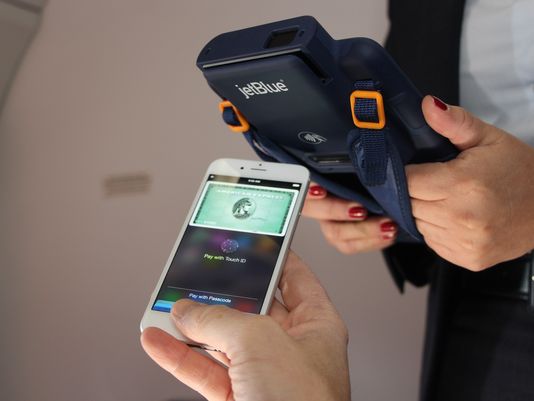Apple Pay is poised to take off — quite literally.Starting next week, passengers on select JetBlue Airways flights can use Apple Pay on their iPhone 6 and 6 Plus handsets to buy food, drinks and certain onboard amenities when the plane reaches cruising altitude. You’ll be able to upgrade to available premium seats, too.
JetBlue is the first airline to accept Apple Pay at 35,000 feet. It almost certainly won’t be the last. “Somebody else doing it always puts pressure on the other guy,” says Eddy Cue, Apple’s senior vice president for Internet software and services.
Paying for stuff on planes can be difficult for the passenger sitting in a cramped seat who is trying to pull a credit card out of their wallet or fumbling with a purse that’s under the seat or in an overhead bin. Apple Pay promises an easier experience.
Apple Pay first got off the ground in September, when Apple introduced the mobile payments system as a banner feature on the latest iPhone.
In April, when the Apple Watch goes on sale, JetBlue travelers wearing the smartwatch will also be able to make payments from their wrists.
“The sky is definitely not the limit when it comes to mobile payments with Apple Pay,” says Marty St. George, a senior vice president at JetBlue.
The carrier is swapping older mobile payment terminals for specially outfitted iPad Minis with NFC-capable cases that are being issued to more than 3,500 inflight crewmembers. The Federal Aviation Administration had to approve the new iPads before they could be used onboard.
The iPads can also accept conventional plastic credit cards to accommodate passengers without the latest iPhone or smartwatch.
JetBlue’s crew is getting video training on the new system. The iPads include an Inflight Service Assistant app with information that helps flight attendants identify frequent fliers or passengers with a birthday. With the FAA’s blessing, the iPads will include the entire inflight manual.
Starting in the third quarter, passengers will be able to use Apple Pay to complete purchases through JetBlue’s own mobile app.
I was treated to an exclusive pre-launch demonstration on a JetBlue flight before it left JFK Airport in New York for Los Angeles. The process works similarly to the way you might buy stuff in stores using Apple Pay. After ordering a salad, I raised the iPhone right up next to a flight attendant’s iPad Mini while pressing my thumb against the secure TouchID fingerprint button on the phone. The transaction, via an American Express card in this case, almost immediately registered. You don’t get a paper receipt — one will be e-mailed.
Wi-Fi is not required to use Apple Pay in the air, though wireless Internet is available on the plane.
Apple Pay on JetBlue begins with transcontinental flights between JFK and airports in San Francisco and Los Angeles. Additional flights will be added in March, with all JetBlue flights slated to accept Apple Pay by June. JetBlue is still working out the details on how to communicate the availability of Apple Pay to passengers.
JetBlue vice president for inflight experience Rachel McCarthy says passengers with Google Wallet or another mobile payments system will be able to pay with their phones “down the road.”
Taking Apple Pay to the skies is important to Apple as it tries to expand the ecosystem for mobile payments beyond such merchants at McDonald’s and Walgreens. USA Technologies recently announced that it was making Apple Pay available at about 200,000 self-service locations: commercial laundry machines, parking kiosks, as well as vending machines in businesses, schools and yes, airports. “Most people would prefer not to carry cash or worry about cash. There’s a lot of opportunity there,” says Cue.
It’ll take awhile before Apple Pay makes huge headway with subways and public transit systems. They’re all different, you’re dealing with local governments, and funding is required, Cue says. “Those things tend to move slower than you and I would like. But it’s clear you’ll see more and more of those, but on a very regional basis.
To date, 750 banks and credit unions are providing Apple Pay to customers. According to Apple, in the three months after launch, Apple Pay has made up more than two out of every three dollars spent on contactless payments across the major U.S. credit card networks. Whole Foods Market has seen mobile payments increase by more than 400%.
But a lot more merchants need to sign on.
Mobile payments go beyond Apple of course. Though it hasn’t caught on in a major way, Google Wallet cannot be dismissed. Meanwhile, Samsung is rumored to be in talks with Massachusetts start-up LoopPay to bring its own payment system to the next flagship Galaxy Phone, expected to be unveiled in early March. LoopPay’s technology, which I’ve reviewed, is compatible with the magnetic-stripe credit card readers that have been employed for decades.
Even if contactless mobile payments are widely adopted on planes, consumers won’t be able to ditch their wallets just yet — you still typically whip out your driver’s license to get past airport security.
“In our world, we really do want to replace the wallet at some point in time, and Apple Pay is the start of that,” Cue says.
The timing on when it’s complete, is still very much up in the air.

